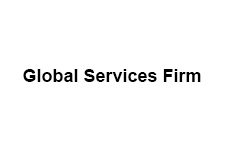


Global Services Firm
Increase Organizational Efficiency and Productivity

SOLUTION
Hitachi Process Intelligence Solution
SERVICE
Enterprise Intelligence
INDUSTRY
Business Challenges
- Identify collaboration habits of top salespeople to replicate their success
- Improve onboarding of new sales-people and track their progress
- Make online meetings more efficient
- Align sales activities with client value and company priorities
Solution
- Hitachi’s Workplace Analytics and Workforce Efficiency solution, including data collection and cleansing, analytics, a custom executive dashboard, and behavioral and change management
Results
- Gained ongoing visibility into salespeople's internal and external collaboration behaviors, network depth and breadth, and growth over time
- Identified opportunity to reclaim $136,000/month in productivity by eliminating unnecessary meeting participants
- Gained insights into improving the new salesperson onboarding process
Business challenge
Understand and replicate top producers' collaboration habits
As part of the reorganization, the sales leadership team wanted to understand how salespeople's collaboration habits affect productivity and efficiency. How do top producers collaborate with other team members, internal organizations and partners—how often and at what point in the sales cycle? What types of interactions (one-on-one meetings, etc.) help new employees become fully productive the fastest—and how long should those interactions continue? Are the right people invited to online meetings, or are some participants redundant, leading to lost productivity?
Self-reporting of behavior tends to be inaccurate; the sales organization wanted hard data. Company leaders also wanted help driving the behavioral and organizational changes needed to replicate the collaboration habits of top producers across the sales force.
Background
The client is a global services firm that sells to enterprises in all industries. The North American sales organization is currently reorganizing to increase efficiency and productivity and align more closely with company priorities.Solution
Uncovering insights with Microsoft Workplace Analytics—and then putting them to work
The company engaged Hitachi to deliver its Workplace Analytics and Workplace Efficiency solution. At the outset, Hitachi met with senior sales leadership to develop hypotheses. A few examples: "Top producers engage early with internal and external partners involved in delivering the solution." "New hires become fully effective after two months." "Regular one-on-one meetings with the sales manager lead to higher performance."
To test the hypotheses, Hitachi used Microsoft Workplace Analytics to look for patterns in data from Microsoft Office 365, the client's CRM system, the sales commission database, social media programs and other sources. The consulting team created a custom executive dashboard that shows:
- Team collaboration history and sales performance for the period selected. Collaboration measures include emails sent (when and to whom) and meetings attended (when and with whom).
- Tenure analysis for sales personnel. The analysis shows how behavior has changed during the onboarding process and subsequently. Metrics include seller engagement as well as network depth and breadth.
- Meeting effectiveness as measured by the number of employees sending multiple emails during the meeting (suggesting a lack of interest or focus), redundant invitees (such as a manager and a direct report), meetings cancelled due to no-shows, etc.
- Manager effectiveness. Measures include the number of one-on-one meetings, team behaviors, and whether managers enable sellers to work independently rather than attending the same meetings.
In the second phase of the engagement, currently in progress, Hitachi is working with senior sales leadership to plan, implement and monitor programs to change collaboration behavior in the ways revealed to be associated with sales performance and organizational efficiency.
Business benefits
Insights about how collaboration habits affect sales performance
Now sales managers and executives can quickly see each salesperson's collaboration history and whether it supports company and organizational goals. Sales managers find it especially useful to see whether their team members are spending an appropriate portion of their time on high-value opportunities, and whether they are bringing internal and external organizations into the sales process at the ideal time. A surprise finding was that a very large portion of all partner communications involved one partner.
Continual improvements to meeting effectiveness
The sales organization now has a way to measure meeting effectiveness. The dashboard shows:
- Whether any participant in a meeting sent three or more emails, a sign that the person was not fully engaged and may not have been needed. At the beginning of the engagement, more than 25% of employees were multi-tasking, which led the client to reconsider whose attendance at meetings was mandatory.
- Whether a participant's manager also attended the meeting. If this happens often, senior leaders can advise the manager to consider delegating more responsibility to the employee. Based on the first three months of data, Hitachi advised the organization that involving redundant people in meetings cost approximately $136,000 monthly in lost productivity.
- Meetings that had to be rescheduled because a key person failed to joined. Habitual no-shows are asked to change their behavior.
Insights about the impact of one-on-one meetings on sales performance
Workforce Analytics disproved the assumption that regular one-on-one meetings led to higher performance. In fact, a high number of one-on-one meetings typically indicated low performance or short tenure.
Higher quality deals
The analysis proved the hypothesis that deals closed by salespeople who engaged the solution delivery team early in the process were far more likely to be completed on time and on budget and meet customer expectations. In response to this insight, the company now directs salespeople to include a member of the delivery team in an early meeting with the customer.
Conclusion
Hitachi’s Workplace Analytics and Workforce Efficiency solution has helped the client pinpoint the collaboration behaviors that drive success. Hitachi’s specialists in organizational and behavioral change management are continuing to put the insights to work to meet the client’s performance and efficiency targets.
Explore More
Digital Strategy Advisory Services
Your Transformation starts here with an experienced guide to drive your digital strategy and transformation journey.
LEARN MORE